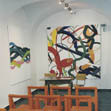texts about zs
The Gallery is inaugurated with this exhibition and intends to re-establish the cultural relationship between Czechoslovakia and neighbouring Europe which was brutally disrupted several times in the last hundred years. I believe we should welcome this opportunity at a time when we are becoming increasingly aware of the fact that the exchange of cultural values does not merely represent a collection of more or less curious national and pseudonational specifications, but also leads to a mutual enrichment of personal values. May I take this opportunity to state that there is more than one good reason for the Central European Gallery to participate in such an activity by exhibiting Zdeněk Sýkora´s works. Sýkora´s creations form by no means part of the folkloric field of interest, but there is really no other place where his works could have been created than in the central European area, where different currents meet, and in Czech creative culture which, I believe, is characterized by its ability to merge and to synthesize such currents.
Sýkora´s works have had a complicated but – looking back – predictable and logical genesis, described in detail by Dr. Josef Hlaváček later on in this catalogue. I would therefore only like to point out some elements of this artist´s personal art synthesis which I consider to be of importance.
Looking for the first time at works of such rational origin and the way they appear to us at the exhibition they seem to be remote from our sensual view of life. In order to see Sýkora´s works as an original attempt to understand the natural phenomena, we do not need to know about his admiration of French – as well as Czech – tradition of impressionism with its charming and sensual view of reality, nor about his career as an artist striving hard to live up to this tradition which has paved the way for his artistic expression. Should we fail to place Zdeněk Sýkora in the current of constructive nothing to do with modernistic dogmas of traditional construction which aimed at a “new” and “technical” creation of nature. His works do not show any such constructions. The abstracted element whose life we can see in the picture is by itself of no significance. Nor is the system of classifying and connecting these elements of any significance. The main aspect is the weave of growing mutual relationships which turns the picture into a model of the world, i.e. of our natural world. Sýkora acquired the foundations of this philosophy during his studies of impressionist painting when he realized that one´s own enchantment by the beauty of the world leads to one´s own expression in a strict and logical order organising a sensible type of quality. Sýkora´s pictures reflect on such an order representing the synthesis of delight and severity.
In the interpretation of these works it is irrelevant whether his earlier works are based on the principle of relative, strict rules or whether his later ones were realised on a larger area following the principle of coincidence. Nature itself, so it seems, knows no such contrasts, and it does not create by rule or coincidence, either. It creates by an order which stands above both abstract expressions. Order is always substantial and individual. And this order combines the paths of nature and artists. If we want to get closer to Zdeněk Sýkora´s pictures we must not ask about their construction but rather about the hermeneutics of their final order.
The question arises to what extent the artist is responsible for his creations. It is the artist who uses the computer in order to fulfil a certain task and reach a certain aim, and who then chooses between various options of design. I would like to point out – in connection with Sýkora´s creations – that it is the artist who create the order and who determines the meaning of colours, areas and mutual relations. Let me state a different example: Johann Sebastian Bach used the same musical weave in numerous cases to turn texts of different types to music. He seems to have succeeded since musical order in itself was a code of his own interpretation and did not reflect any particular message. Perhaps we can even say that it was the code of whatever permits us to exist and orientate ourselves in this world. I believe that this is where we must look for and find the demands and messages of Zdeněk Sýkora´s pictures. They do not portray a sensual contemplation on beautiful nature or logical construction. Nor are they any form of protest or outcry. They are a meditation on order which makes us a part of this world and which permits us to find ourselves in it. Isn´t that something?
Translation Jutta Horton


